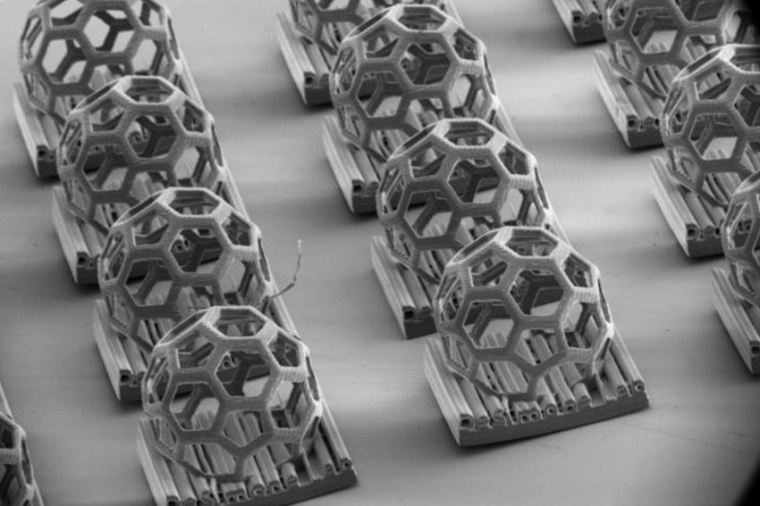New high-speed microscale 3D printing technique
The new scalable, high-resolution, 3D printing technique is based on roll-to-roll continuous liquid interface production.
3D-printed microscopic particles have applications in drug and vaccine delivery, microelectronics, microfluidics, and abrasives for intricate manufacturing. However, the need for precise coordination between light delivery, stage movement, and resin properties makes scalable fabrication of such custom microscale particles challenging. Now, researchers at Stanford University have introduced a more efficient processing technique that can print up to one million highly detailed and customizable microscale particles a day.

“We can now create much more complex shapes down to the microscopic scale, at speeds that have not been shown for particle fabrication previously, and out of a wide range of materials,” said Jason Kronenfeld, PhD candidate in the DeSimone lab at Stanford. This work builds on a printing technique known as continuous liquid interface production, or CLIP, introduced in 2015. CLIP uses UV light, projected in slices, to cure resin rapidly into the desired shape. The technique relies on an oxygen-permeable window above the UV light projector. This creates a “dead zone” that prevents liquid resin from curing and sticking to the window. As a result, delicate features can be cured without ripping each layer from a window, leading to faster particle printing.
“Using light to fabricate objects without molds opens up a whole new horizon in the particle world,” said Joseph DeSimone. “And we think doing it in a scalable manner leads to opportunities for using these particles to drive the industries of the future. We’re excited about where this can lead and where others can use these ideas to advance their own aspirations.”
The process that these researchers invented for mass producing uniquely shaped particles that are smaller than the width of a human hair is reminiscent of an assembly line. It starts with a film that is carefully tensioned and then sent to the CLIP printer. At the printer, hundreds of shapes are printed at once onto the film and then the assembly line moves along to wash, cure, and remove the shapes – steps that can all be customized based on the shape and material involved. At the end, the empty film is rolled back up, giving the whole process the name roll-to-roll CLIP, or r2rCLIP. Prior to r2rCLIP, a batch of printed particles would need to be manually processed, a slow and labor-intensive process. The automation of r2rCLIP now enables unprecedented fabrication rates of up to one million particles per day.
“You don’t buy stuff you can’t make,” said DeSimone. “The tools that most researchers use are tools for making prototypes and test beds, and to prove important points. My lab does translational manufacturing science – we develop tools that enable scale. This is one of the great examples of what that focus has meant for us.” There are tradeoffs in 3D printing of resolution versus speed. For instance, other 3D printing processes can print much smaller – on the nanometer scale – but are slower. And, of course, macroscopic 3D printing has already gained a foothold in mass manufacturing, in the form of shoes, household goods, machine parts, football helmets, dentures, hearing aids, and more. This work addresses opportunities in between those worlds.
“We’re navigating a precise balance between speed and resolution,” said Kronenfeld. “Our approach is distinctively capable of producing high-resolution outputs while preserving the fabrication pace required to meet the particle production volumes that experts consider essential for various applications. Techniques with potential for translational impact must be feasibly adaptable from the research lab scale to that of industrial production.”
The researchers hope that the r2rCLIP process sees wide adoption by other researchers and industry. Beyond that, DeSimone believes that 3D printing as a field is quickly evolving past questions about the process and toward ambitions about the possibilities. “r2rCLIP is a foundational technology,” said DeSimone. “But I do believe that we’re now entering a world focused on 3D products themselves more so than the process. These processes are becoming clearly valuable and useful. And now the question is: What are the high-value applications?”
For their part, the researchers have already experimented with producing both hard and soft particles, made of ceramics and of hydrogels. The first could see applications in microelectronics manufacturing and the latter in drug delivery in the body. “There’s a wide array of applications, and we’re just beginning to explore them,” said Maria Dulay, senior research scientist in the DeSimone lab. (Source: Stanford U.)
Link: DeSimone Research Group, Dept. of Chemical Engineering, Stanford University, Stanford, USA











